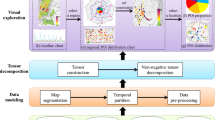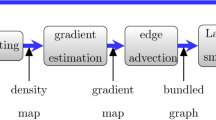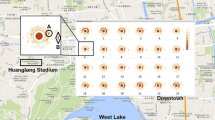Abstract
In the era of big data, large amounts of detailed spatial interaction data are readily available due to the increasing pervasiveness of location-aware devices and techniques. Such data are often applied in the research of spatial structures, land use characteristics, and human activity regularities. However, visualizing such data on maps is a great challenge. Existing approaches either encounter overlapping and intersection problems, which may cause information loss or distortion, or are unable to present interaction characteristics. Consequently, the functional and positional features of places and human mobility trends are not fully demonstrated. We propose direction-based pattern maps, a new visualization method to display the spatial interaction pattern of every place by aggregating spatial interaction data in cardinal directions. This approach can well represent local interaction characteristics and is applicable to different spatial scales. Owing to regular hexagonal tessellations, it can avoid cluttering problems and maintain a geographical context. A case study using Beijing taxi trip data is conducted to validate the usefulness of our approach.
Graphical Abstract










Similar content being viewed by others
References
Abel GJ, Sander N (2014) Quantifying global international migration flows. Science 343(6178):1520–1522
Andrienko N, Andrienko G (2011) Spatial generalization and aggregation of massive movement data. IEEE Trans Visual Comput Graph 17(2):205–219
Andrienko G, Andrienko N, Fuchs G, Wood J (2017) Revealing patterns and trends of mass mobility through spatial and temporal abstraction of origin-destination movement data. IEEE Trans Visual Comput Graphics 23(9):2120–2136
Batten DF, Boyce DE (1987) Spatial interaction, transportation, and interregional commodity flow models. In: Nijkamp P (ed) Handbook of regional and urban economics, vol 1. Elsevier, Amsterdam, pp 357–406
Birkin M, Clarke G, Clarke M (2010) Refining and operationalizing entropy-maximizing models for business applications. Geogr Anal 42(4):422–445
Brewer CA, Pickle L (2002) Evaluation of methods for classifying epidemiological data on choropleth maps in series. Ann Assoc Am Geogr 92(4):662–681
Brewer CA, Hatchard GW, Harrower MA (2003) ColorBrewer in print: a catalog of color schemes for maps. Cartogr Geogr Inf Sci 30(1):5–32
Buchin K, Speckmann B, Verbeek K (2011) Flow map layout via spiral trees. IEEE Trans Visual Comput Graphics 17(12):2536–2544
Cano RG, Buchin K, Castermans THA, Pieterse A, Sonke WM, Speckmann B (2015) Mosaic drawings and cartograms. Comput Graph Forum 34(3):361–370
Carr DB, Olsen AR, White D (1992) Hexagon mosaic maps for display of univariate and bivariate geographical data. Cartogr Geogr Inf Syst 19(4):228–236
Chen S, Chen S, Wang Z, Liang J, Yuan X, Cao N, Wu Y (2016). D-Map: visual analysis of ego-centric information diffusion patterns in social media. In: Proceedings of IEEE conference on visual analytics science and technology (VAST’16), pp 41–50
Cui W, Zhou H, Qu H, Wong PC, Li X (2008) Geometry-based edge clustering for graph visualization. IEEE Trans Vis Comput Graph 14(6):1277–1284
Dacey MF (1965) The geometry of central place theory. Geografiska annaler. Ser B Hum Geogr 47(2):111–124
Dent BD, Torguson JS, Hodler TW (1999) Cartography: thematic map design, 5th edn. WCB/McGraw-Hill, Boston
Drake DAR, Mandrak NE (2010) Least-cost transportation networks predict spatial interaction of invasion vectors. Ecol Appl 20(8):2286–2299
Evans IS (1977) The selection of class intervals. Trans Inst Br Geogr 2(1):98–124
Fotheringham AS (1981) Spatial structure and distance-decay parameters. Ann Assoc Am Geogr 71(3):425–436
Fotheringham AS, O’Kelly ME (1989) Spatial interaction models: formulations and applications. Kluwer Academic Publishers, Dordrecht
Goodchild MF, Yuan M, Cova TJ (2007) Towards a general theory of geographic representation in GIS. Int J Geogr Inf Sci 21(3):239–260
Guo D (2007) Visual analytics of spatial interaction patterns for pandemic decision support. Int J Geogr Inf Sci 21(8):859–877
Guo D, Zhu X, Jin H, Gao P, Andris C (2012) Discovering spatial patterns in origin-destination mobility data. Trans GIS 16(3):411–429
Jenks GF (1967) The data model concept in statistical mapping. Int Yearb Cartogr 7:186–190
Jenny B, Stephen DM, Muehlenhaus I, Marston BE, Sharma R, Zhang E, Jenny H (2016) Design principles for origin-destination flow maps. Cartogr Geogr Inf Sci 45(1):62–75
Jiang X, Zheng C, Tian Y, Liang R (2015) Large-scale taxi O/D visual analytics for understanding metropolitan human movement patterns. J Vis 18(2):185–200
Kamgar-Parsi B, Sander WA (1989) Quantization error in spatial sampling: comparison between square and hexagonal pixels. In: Proceedings of IEEE computer society conference on computer vision and pattern recognition 1989 (CVPR ‘89), pp 604–611
Kong X, Liu Y, Wang Y, Tong D, Zhang J (2017) Investigating public facility characteristics from a spatial interaction perspective: a case study of Beijing hospitals using taxi data. ISPRS Int J GeoInf 6(2):38
Lam DN, Quattrochi DA (1992) On the issues of scale, resolution, and fractal analysis in the mapping sciences. Prof Geogr 44(1):88–98
Lam H, Bertini E, Isenberg P, Plaisant C, Carpendale S (2011). Seven guiding scenarios for information visualization evaluation. Technical Report, University of Calgary. http://innovis.cpsc.ucalgary.ca/innovis/uploads/Publications/Publications/Lam_2011_SGS.pdf
Liu X, Gong L, Gong Y, Liu Y (2015a) Revealing travel patterns and city structure with taxi trip data. J Transp Geogr 43:78–90
Liu Y, Liu X, Gao S, Gong L, Kang C, Zhi Y, Chi G, Shi L (2015b) Social sensing: a new approach to understanding our socioeconomic environments. Ann Assoc Am Geogr 105(3):512–530
Liu X, Kang C, Gong L, Liu Y (2016) Incorporating spatial interaction patterns in classifying and understanding urban land use. Int J Geogr Inf Sci 30(2):334–350
Masser I, Brown PJ (1977) Spatial representation and spatial interaction. Pap Reg Sci Assoc 38(1):71–92
Murray AT, Liu Y, Rey SJ, Anselin L (2012) Exploring movement object patterns. Ann Reg Sci 49(2):471–484
Rae A (2009) From spatial interaction data to spatial interaction information? Geovisualisation and spatial structures of migration from the 2001 UK census. Comput Environ Urban Syst 33(3):161–178
Robertson PK, O’Callaghan JF (1986) The generation of color sequences for univariate and bivariate mapping. IEEE Comput Graph Appl 6(2):24–32
Roy JR, Thill JC (2004) Spatial interaction modelling. Pap Reg Sci 83(1):339–361
Sahr K, White D, Kimerling AJ (2003) Geodesic discrete global grid systems. Cartogr Geogr Inf Sci 30(2):121–134
Taylor PJ (1975) Distance decay in spatial interactions. In: Openshaw S (ed) Concepts and techniques in modern geography. Geo Books, Norwick, pp 3–35
Tobler WR (1976) Spatial interaction patterns. J Environ Syst 6(4):271–301
Tobler WR (1987) Experiments in migration mapping by computer. Am Cartogr 14(2):155–163
Trumbo BE (1981) A theory for coloring bivariate statistical maps. Am Stat 35(4):220–226
Von Landesberger T, Brodkorb F, Roskosch P, Andrienko N, Andrienko G, Kerren A (2016) MOBILITYGRAPHS: visual analysis of mass mobility dynamics via spatio-temporal graphs and clustering. IEEE Trans Vis Comput Graph 22(1):11–20
Wattenberg M (2002) Arc diagrams: visualizing structure in strings. In: Proceedings of the IEEE symposium on information visualization 2002 (INFOVIS 2002), pp 110–116
Wood J, Dykes J, Slingsby A (2010) Visualisation of origins, destinations and flows with OD maps. Cartogr J 47(2):117–129
Wüthrich CA, Stucki P (1991) An algorithmic comparison between square-and hexagonal-based grids. CVGIP: Graph Models Image Process 53(4):324–339
Yang Y, Dwyer T, Goodwin S, Marriott K (2017) Many-to-many geographically-embedded flow visualisation: an evaluation. IEEE Trans Vis Comput Graph 23(1):411–420
Zheng Y (2015) Trajectory data mining: an overview. ACM Trans Intell Syst Technol 6(3):29
Zhu X, Guo D (2014) Mapping large spatial flow data with hierarchical clustering. Trans GIS 18(3):421–435
Acknowledgements
This research was supported by the National Natural Science Foundation of China (Grant Nos. 41830645, 41625003, and 41771425), the National Key R&D Program of China (Grant No. 2017YFB0503602), and the Open Funding Project of State Key Laboratory of Virtual Reality Technology and Systems (Grant No. 011177220010020).
Author information
Authors and Affiliations
Corresponding author
Additional information
Publisher's Note
Springer Nature remains neutral with regard to jurisdictional claims in published maps and institutional affiliations.
Electronic supplementary material
Below is the link to the electronic supplementary material.
Rights and permissions
About this article
Cite this article
Yao, X., Wu, L., Zhu, D. et al. Visualizing spatial interaction characteristics with direction-based pattern maps. J Vis 22, 555–569 (2019). https://doi.org/10.1007/s12650-018-00543-4
Received:
Revised:
Accepted:
Published:
Issue Date:
DOI: https://doi.org/10.1007/s12650-018-00543-4




